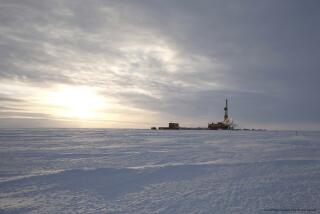Secret in the North
- Share via
The well-kept secret of 1 KIC Jago River will be told before long, and the nation finally may get some specific data on the oil potential of the Alaska National Wildlife Refuge east of Prudhoe Bay on the Arctic Ocean. No. 1 KIC Jago River is a wildcat well drilled in 1985-86 by Chevron Corp. on native-owned land not far from the coastal plain of the wildlife refuge.
Rumor has it that the well produced good oil shows, but no data have been disclosed under a confidentiality agreement between Chevron and the federal government. The agreement will expire this summer, and the secret--or non-secret--will be out. And even more information may be forthcoming because a second well now is being drilled in the area by Tenneco. The firm’s 1 OCS Y-0943 is being drilled in 65 feet of water six miles off the refuge coast.
Whether there is oil under the refuge--and, if so, how much--is the focus of the major environmental battle now before Congress. The issue is whether to allow the Department of the Interior to lease the region to oil companies for exploration and development. Environmental groups are adamantly opposed. Oil companies and the Reagan Administration are battling for legislation to open the refuge for oil development.
The industry talks about Prudhoe Bay’s being depleted in coming years and the prospect that the refuge may be hiding another super-giant field--perhaps the last such field to be found in the United States. The U.S. Geological Survey has said that there is a 19% chance of finding oil on the coastal plain, and that if there is oil there is a 95% chance that the field will contain at least 4.8 billion barrels and a 5% chance that it will be a field the size of Prudhoe Bay--10 billion barrels or more.
The oil companies promote drilling by declaring that the coastal plain looks just like Prudhoe Bay and that the development of a coastal-plain field would require far less construction and environmental disruption. The U.S. Geological Survey says that the plain and Prudhoe Bay do share similarities, but also, according to the Oil & Gas Journal, the federal report “underscores the fact that ANWR has a geological complexity unique on the North Slope and thus will require thorough exploration.” The geography of the plain was described as more like the western overthrust belt of the Rockies than Prudhoe Bay. Prudhoe Bay required only 10 discovery wells to establish commercial production. The overthrust belt required about 500 wells.
The results of the Chevron and Tenneco wells, no matter what they show, are certain to add more fuel to the leasing debate. In reporting this information to Congress and the public, it is incumbent on the Department of the Interior to present it completely and without bias. In the debate thus far, the department has been too enthusiastic a cheerleader for the oil companies in promoting the prospects for oil and its strategic importance to the country. At the same time, the department--which has the responsibility for protecting America’s special places like wildlife refuges--has understated the value of the coastal plain as the last intact ecological system of its kind in the United States, and has glossed over the possibility of environmental disruption.
More to Read
Sign up for Essential California
The most important California stories and recommendations in your inbox every morning.
You may occasionally receive promotional content from the Los Angeles Times.













